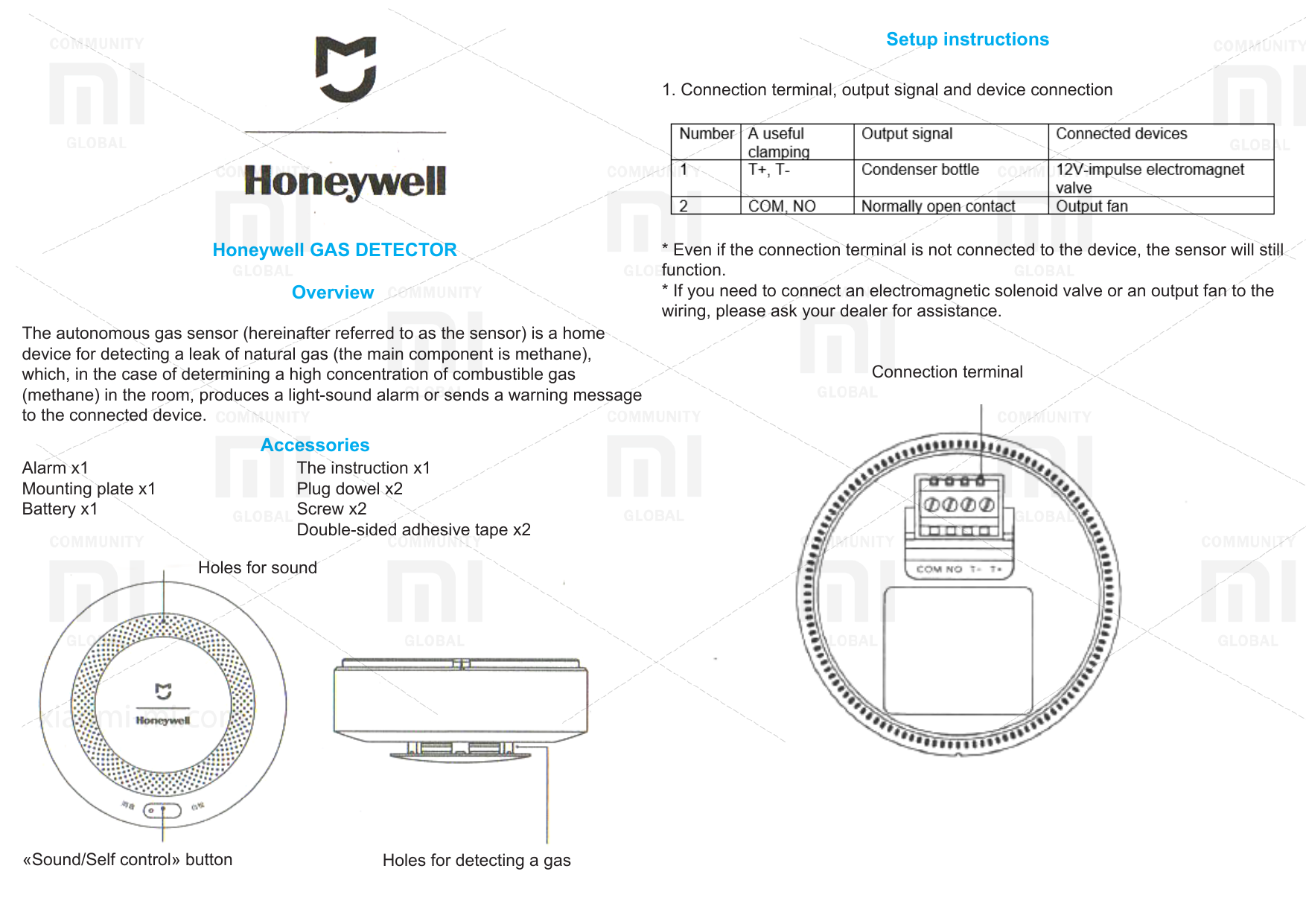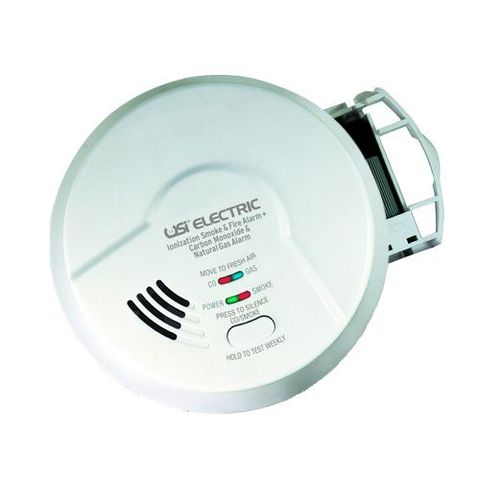Summary of the content on the page No. 1
Usi MCN108 Pdf User Manuals. View online or download Usi MCN108 Installation Instructions Manual. USI Electric MICN109 Description. The Combination Smoke Alarm features four LED indicators for power, smoke, carbon monoxide and natural gas indication. The fire detector emits a loud 85 decibel alarm to be easily heard in case of an emergency. Alarm incorporates a self-diagnostic feature which will perform a self-check when the alarm powers on to ensure proper working order. Includes instruction manuals, spec sheets and high quality images for Universal Security Instruments and USI Electric brand products. USI Electric MICN109 Hardwired 3-in-1 Smoke, Carbon Monoxide and Natural Gas Alarm. Documents: MANUAL.pdf. Quick Find Feature.pdf. Reference Guide.pdf.
MODEL MICN102, MICN102L
IONIZATION SMOKE ALARM,
CARBON MONOXIDE ALARM AND
NATURAL GAS ALARM
WITH BATTERY BACKUP
AND SILENCE FEATURE
MODEL MICN109, MICN109L
IONIZATION SMOKE ALARM,
CARBON MONOXIDE ALARM AND
NATURAL GAS ALARM
WITH BATTERY BACKUP
AND SILENCE FEATURE
PLEASE READ AND SAVE!
THANK YOU for purchasing this combination alarm. It is designed to detect smoke, carbon monoxide
and natural gas (methane) which reaches the sensor. It is not designed to detect fire, heat, flames or
any other gas.

Summary of the content on the page No. 2
ALARM LIMITATIONS AND FUNCTIONS This Combination Ionization Smoke/Carbon Monoxide (CO)/Natural Gas alarm requires constant 120 VAC power to operate properly. There are three basic smoke alarm types: IoPhic , Ionization and Photoelectric. IoPhic is an ionization alarm containing a patent-pending Universal Smoke Sensing Technology. IoPhic alarms are very effective at detecting fast flaming fires and also respond very quickly to slow smoldering fires - up to 87% faster than the maxim
Summary of the content on the page No. 3
WHAT YOU SHOULD KNOW ABOUT CO Carbon monoxide (CO) is an insidious poison. It is a colorless, odorless, tasteless gas. It is a cumulative poison. Even low levels of CO have been shown to cause brain and other vital organ damage in unborn infants with no effect on the mother. The following symptoms are related to CARBON MONOXIDE POISONING and should be discussed with ALL members of the household: MILD EXPOSURE Slight headache, nausea, vomiting, fatigue (often described as 'flu-like' symptoms). ME
Summary of the content on the page No. 4
Locate the first combination alarm in the immediate area of the bedrooms. Try to protect the escape route as the bedrooms are usually farthest from an exit. If more than one sleeping area exists, locate additional combination alarms in each sleeping area. If a hall is more than 40 feet (12 meters) long, install a combination alarm at each end. Locate additional smoke alarms to protect any stairway as stairways act like chimneys for smoke and heat. Locate at least one combination smoke alar
Summary of the content on the page No. 5
In general, install combination Smoke, CO and Gas Alarms: • WHERE YOU CAN HEAR THE ALARM FROM ALL SLEEPING AREAS. • In or near bedrooms and living areas or wherever you suspect a smoke, gas or CO exposure is likely. • On each level of a multilevel home. IMPORTANT! Installation in an improper location can affect the sensitive electronic components in this alarm. Please review WHERE THIS ALARM SHOULD NOT BE INSTALLED (see Page 6). Not suitable for installation in hazardous locations as defined in
Summary of the content on the page No. 6
RECOMMENDED PLACEMENT: NOTE: For any location, make sure no door or other obstruction could prevent the smoke, carbon monoxide or gas from reaching the alarm. WHERE THIS ALARM SHOULD NOT BE INSTALLED To avoid causing damage to the unit, to provide optimum protection, and to prevent unnecessary alarms. Do NOT locate this alarm: • In garages, kitchens, crawl spaces and unfinished attics. Avoid extremely dusty, dirty or greasy areas. Installation in these areas could lead to nuisance alarms, may ex
Summary of the content on the page No. 7
• Good ventilation is recommended when household cleaning supplies or similar contaminants are used. • Excessive spillage or reverse venting of fuel-burning appliances caused by outdoor ambient conditions, such as: Wind direction and/or velocity, including high gusts of wind. Heavy air in the vent pipes (cold/ humid air with extended periods between cycles). Negative pressure differential resulting from the use of exhaust fans. Simultaneous operation of several fuel-burning appliances comp
Summary of the content on the page No. 8
Smoke Detector Flashing Blue Light
2. Insert the pin into the hole for the feature you are activating. Refer to the diagram below for correct placement. INSERT ALARM INSERT BATTERY LOCKING PIN HERE LOCKING PIN HERE TO DEACTIVATE THE LOCKING FEATURES: To remove the alarm for cleaning or servicing or to replace the battery, you must first remove the appropriate locking pin, if it has been installed. 1. Turn off AC power to the circuit. 2. Use long nose pliers to pull the locking pin out of the hole. 3. It is now possible to remove
Summary of the content on the page No. 9
The yellow wire is used only for multiple station operations with USI ELECTRIC or UNIVERSAL Model alarms only. Connecting this yellow wire to any other circuits may result in damage and alarm malfunction. When alarms are interconnected, all alarms must be powered from a single AC branch circuit. If local codes do not permit, be sure the neutral wire is common to both phases. The maximum wire run distance between the first and last alarm/device in an interconnected system is 1,000 feet. NOTE: Use
Summary of the content on the page No. 10
SMOKE ALARM LATCHING LED INDICATOR: The alarm had prevously detected smoke and had alarmed. The red LED is off and blinks on every 5 seconds until reset. Follow the reset instructions to remove the latching LED. CO ALARM LATCHING LED INDICATOR: The alarm had previously detected CO and had alarmed. The red LED is off and blinks on every 5 seconds until reset. Follow the reset instructions to remove the latching LED. GAS ALARM LATCHING LED INDICATOR: The alarm had previously detected GAS and had a
Summary of the content on the page No. 11
WHAT TO DO IF NATURAL GAS IS DETECTED: If you hear the alarm horn sound 1 beep per second, gas has been detected. Evacuate everyone from the building. 1. Leave the house immediately, opening doors and windows as you leave. 2. Do not use your telephone or appliances. Do not turn any light switches off or on. Any spark or flame could ignite the gas. 3. Call 911 and your gas company from a phone that is away from your home. 4. Do not reenter the area until the source of the leak is found and correc
Summary of the content on the page No. 12
NEVER use an open flame of any kind to test this smoke alarm. You might accidentally damage or set fire to the smoke alarm or to your home. The built-in test switch accurately tests the smoke alarm's operation as required by Underwriters Laboratories Inc. (UL). (UTHA) Sensitivity Indicating Means The sensitivity indicating means for this Smoke and Fire Alarm is the use of the analyzer for Smoke Detectors Model 501-A or 501-A/Bat Aerosol Generator Manufactured by Gemini Scientific Corp., 1122-B A
Summary of the content on the page No. 13
BACKUP BATTERY REPLACEMENT Disconnect AC power before changing battery. Shock hazard exists if AC power is miswired. The alarm uses a 9 Volt battery. The battery should last for at least one year under normal operating conditions. The alarm has a low battery indicator, an audible beep or chirp. It will operate at approx. 40 second intervals for a minimum of 7 days. When this indication occurs, replace the battery with an Alkaline type (Energizer #522, Duracell #MN1604), or Lithium type (Ultrali
Summary of the content on the page No. 14
The following conditions can result in transient CO situations: 1. Excessive spillage or reverse venting of fuel-burning appliances caused by outdoor ambient conditions, such as: • Wind direction and/or velocity, including high gusts of wind. Heavy air in the vent pipes (cold/ humid air with extended periods between cycles). • Negative pressure differential resulting from the use of exhaust fans. • Simultaneous operation of several fuel-burning appliances competing for limited internal air. • Ve

Summary of the content on the page No. 15
WHAT TO DO WHEN THE ALARM SOUNDS o Leave immediately by your plan of escape. Every second counts, so don't waste time getting dressed or picking up valuables. o In leaving, don't open any inside door without first feeling its surface. If hot, or if you see smoke seeping through cracks, don't open that door! Instead, use your alternate exit. If inside door is cool, place your shoulder against it, open it slightly and be ready to slam it shut if heat and smoke rush in. o Stay close to the floor

Summary of the content on the page No. 16
Usi Micn109 Instruction Manual

OPERATIONAL SUMMARY CONDITION OF ALARM AUDIBLE & VISUAL SIGNALS BEFORE SOLUTION / RECOMMENDATION POWER GAS CO SOLUTION / HORN GREEN LED BLUE LED RED LED RECOMMENDATION Silent On and Blinks Off Off AC Power is present. DC power is present off approx every 20 seconds Silent Off and Blinks Off Off Alarm is powered by battery backup. AC Power is not on approx every present. Check the breaker or fuse box for power. If the 40 seconds breaker or fuse box looks normal, call a licensed electrician for as

Summary of the content on the page No. 17
TEN YEAR LIMITED WARRANTY MODELS MICN102, MICN102L MODELS MICN109, MICN109L USI ELECTRIC, INC./UNIVERSAL SECURITY INSTRUMENTS, INC. ('USI') warrants your USI product to be free from defects in material and workmanship for a period of ten (10) years from the date of purchase. This warranty shall not apply to any batteries used in the product or to any damage which may be caused by such batteries. This warranty applies only to the original consumer purchaser and only to products used in normal res
